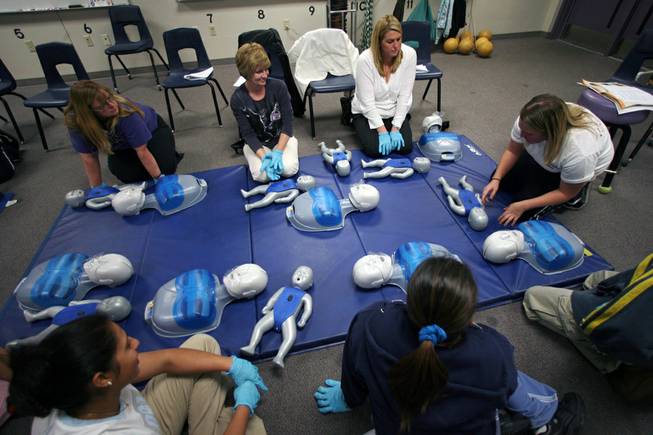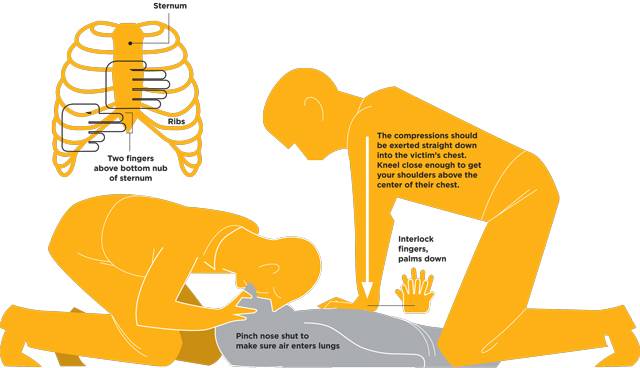
Ashlee Wellman, right, a lifeguard with Las Vegas Lifeguards 2U, demonstrates how to give lifesaving CPR on a dummy during a CPR training class for parents and students at Roger D. Gehring Elementary.
Monday, July 13, 2015 | 2 a.m.
Related stories
Simply put, cardiopulmonary resuscitation saves lives — about 92,000 each year in the United States. The key is knowing when it is needed and how it is done. About 92 percent of sudden cardiac arrest victims die before they reach the hospital, but statistics show immediate CPR can double or triple a person’s chance for survival. CPR also can be essential for prolonging the life of people who have choked, almost drowned, overdosed, been shocked, suffocated or suffered a severe allergic reaction. CPR enables oxygenated blood to circulate to vital organs such as the brain and heart, and can keep a person alive until more advanced medical care can be given.
There are two types of CPR: full CPR, which combines mouth-to-mouth breathing with chest compressions; and hands-only CPR, which forgoes rescue breaths. Hands-only CPR was developed in the mid-2000s to eliminate the “ick” factor many potential rescuers associated with putting their mouths on a victim.
BEFORE YOU START, do these tasks
Check for responsiveness by tapping the person’s shoulder and shouting, “Are you OK?”
Call 911.
Place the person face up, supporting his or her head, neck and back in a straight line. Check quickly —
not more than 10 seconds — for breathing. Occasional gasps are not breathing.
If the person is breathing, maintain his or her airway and monitor the person for any changes.
If he or she is not breathing, begin CPR.

1. Position the victim
Unless there is an injury that prevents moving the victim, get them on their back and tilt the head back slightly.
2. Check the airway for obstruction
With the chin high, the airway is mostly open unless there is an obstruction. With a finger, sweep the mouth. But don’t go too deep or you could make the victim gag or reflexively bite down.
3. Where to place your hands
Find the nub (actually called the xiphoid process) at the bottom of the victim’s sternum. Two finger spaces above that nub is where you will place your palms for the compressions. Interlock your fingers, both palms facing down. The compressions to follow need to be forceful enough to push down the rib cage about 2 inches.
Full CPR
Full CPR combines rescue breaths with chest compressions. It is best used in drowning situations, for people who collapse due to breathing problems and for people who have been found unconscious.
1. Give 30 chest compressions at a rate of 100 compressions per minute. Push hard and push fast in the middle of the person’s chest.
2. Give two rescue breaths. Tilt the head back and lift the chin. Pinch the nose shut, then use your mouth to make a complete seal over the person’s mouth. Blow in for about one second, making sure the person’s chest clearly rises. Give the rescue breaths in quick succession, one after the other.
3. Don’t stop. Continue cycles of CPR until the person begins breathing, an automated external defibrillator is ready to use, trained medical personnel arrive, you become too exhausted to continue or the scene becomes unsafe.
Only full CPR is recommended for infants and young children who haven’t yet hit puberty.
Hands-only
Hands-only CPR involves no mouth-to-mouth contact and is best used when someone suddenly collapses outside a medical setting. If you are untrained, provide hands-only CPR.
1. Place the heel of one hand on the center of the patient’s chest. Place the heel of the other hand on top of the first hand, lacing your fingers together.
2. Keeping your arms straight and your shoulders directly over your hands, give rapid, uninterrupted compressions, at least 100 per minute. Push hard and fast so the chest compresses at least 2 inches. Let the chest rise completely before pushing down again.
3. See Step 3 for Full CPR.
A study published in the Journal of the American Medical Association showed hands-only CPR was just as effective as full CPR in many cases involving adults.
Will it break ribs?
Possibly. CPR has been shown to cause rib or breastbone fractures in at least one-third of cases. However, the fractures rarely caused serious internal bleeding or death. On the other hand, the chance of surviving an out-of-hospital cardiac arrest is near zero for victims who do not receive immediate chest compressions.
Get educated
CPR can be lifesaving, but it is most successful when performed by somebody with training. Accredited CPR courses are offered throughout the valley. The Southern Nevada Chapter of the American Red Cross hosts classroom and online courses almost weekly. Or download free digital course materials from redcross.org.
Sources: American Heart Association, American Red Cross, B.E. CPR, University of Washington

Join the Discussion:
Check this out for a full explanation of our conversion to the LiveFyre commenting system and instructions on how to sign up for an account.
Full comments policy